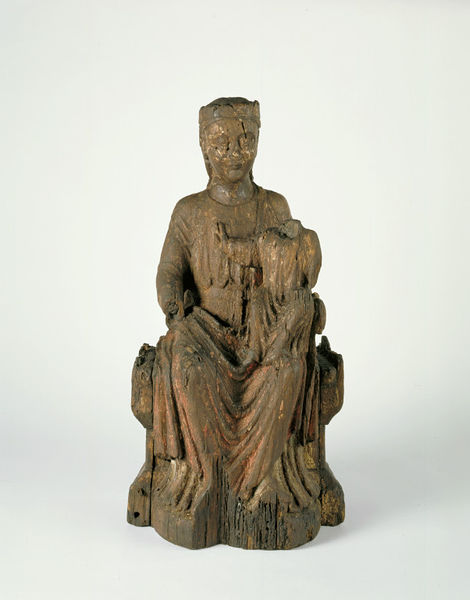
An article appears in today’s Catholic Herald co-authored by me and Fr Michael Rear (author of Walsingham: Pilgrims and Pilgrimage) about the mysterious Langham Madonna, a 13th-century (apparently) statue of a seated Virgin and Child of the kind that adorned many English churches before the Reformation, and now in London’s Victoria & Albert Museum. What is special about the Langham Madonna is that it is the only statue of its kind to have survived, albeit in a rather damaged state. Yet it is also possible that the Langham Madonna is very much more special than this, and in the article Fr Rear and I argue that there is a compelling circumstantial case to be made that the Langham Madonna may be the holiest of all medieval English religious images: the statue of Our Lady of Walsingham.
We are fortunate to have a fairly detailed image of this statue, which was depicted on the seal of Walsingham Priory – although we have no way of knowing how accurate the seal’s depiction was. What can be said, however, is that what remains of the Langham Madonna is strikingly similar to the seal image. This similarity on its own, of course, is not enough to show that the Langham statue is Our Lady of Walsingham – it could be a copy of the famous statue, or just an image of a similar type from a time when portrayals of the Virgin enthroned were popular in English religious art. There are, however, good reasons to believe the Langham statue could be the famous Walsingham image – partly because it can now be shown that the provenance of the Langham Madonna was inaccurately recorded when the statue was purchased by the V&A, and partly because the statue bears physical signs of traits apparently unique to the image of Our Lady of Walsingham. The details of these arguments can be found in the original article.
The most obvious objection to the theory that the Langham Madonna is Our Lady of Walsingham is, of course, the apparent destruction of the image (recorded by chroniclers) in 1538. However, the accounts of the destruction of ‘the witch of Walsingham’ (as the Reformers called the image) are vague, with some accounts claiming the statue was burnt in the courtyard of Thomas Cromwell’s house in Chelsea, and others placing the burning at Smithfield. Accounts of the destruction of relics at the time of the dissolution of the monasteries are often inaccurate (cf. false accounts of the burning of St Thomas Becket), and it is of course possible that another statue was substituted for the Walsingham image – perhaps by commissioners embarrassed that they had been unable to locate the original image, and eager to please Cromwell. Other famous Marian statues, such as the statue of Our Lady of Grace at Ipswich (which was apparently spirited to Nettuno in Italy) and the statue being concealed by the recusant Edward Rookwood at Euston in 1578, escaped destruction – at least for a while. It is hard to imagine that no effort was made to preserve Our Lady of Walsingham, especially since the dissolution of the priory and destruction of the Holy House were vigorously opposed by local people in 1537.
Fr Rear and I conclude that, on balance, the Langham Madonna is likely to be the image of Our Lady of Walsingham. At the very least, the Langham statue is a copy of the Walsingham statue so close to the original that it would have been barely distinguishable from it. But we may never know the truth.